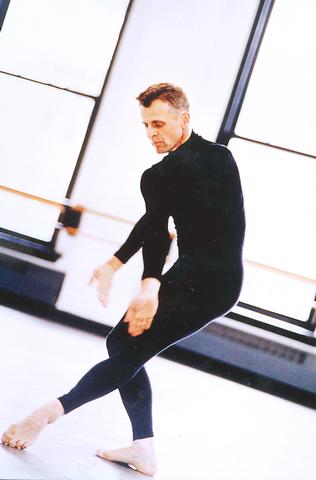Mikhail Barishnikov, one of the world's leading modern dancers, is making a first trip to Taipei at the end of the month along with his experimental dance group, the White Oak Dance Project.
The troupe will perform pieces created last year, including Peccadillos, choreographed by Mark Morris, For the Love of Rehearsal, by David Gordon, Whizz, by Deborah Hay and See Through Knot by John Jasperse.

PHOTO COURTESY OF NEW ASPECT ART
Barishnikov, 52, is one of Russia's greatest ballet dancers often mentioned in the same breath as the dancing legend Rudolf Nureyev (1938-93). But since his defection to the US in 1975, he has broadened his career beyond that of his predecessor to make five films, among them The White Night, which told the story of his escape from the Soviet Union and brought him fame outside the realm of dance. In 1989, he performed in a Broadway show Metamorphosis, earning a Tony Award nomination.
Arriving in the US at 26, Baryshnikov immediately joined the American Ballet Theater (ABT) in the capacity of principal dancer. In 1979, he left the theater and worked with George Ballenchine at New York City Ballet. In the 1980s, he returned to ABT to serve as its artistic director for the next 10 years.
In the 1990s, Baryshnikov took up dancing again with the White Oak Dance Project, a team he founded with choreographer Mark Morris. This experimental dance troupe, made of some of the best modern dancers, has performed more than 30 shows around the world, showcasing the works of such young choreographers as Jeremy Robbins and Paul Taylor.
Taiwan's Cloud Gate Dance Theater (雲門舞集) founder Lin Hwai-min (林懷民) has lauded Baryshnikov as an exceptional dancer who, with each piece, challenges the status quo of dance and breaks new ground. Lin further says that while Russian dancers are known for their extravagant technique, Barishnikov is different, enhancing his performances with musicality and natural body movement.
Performance notes
When Feb. 23, 24 and 25
Where Dr Sun Yat-sen Memorial Hall
Tickets 2/23, NT$800-NT$3,000; 2/24, NT$1,000-NT$3,000;
2/25, NT$800-NT$3,000

June 23 to June 29 After capturing the walled city of Hsinchu on June 22, 1895, the Japanese hoped to quickly push south and seize control of Taiwan’s entire west coast — but their advance was stalled for more than a month. Not only did local Hakka fighters continue to cause them headaches, resistance forces even attempted to retake the city three times. “We had planned to occupy Anping (Tainan) and Takao (Kaohsiung) as soon as possible, but ever since we took Hsinchu, nearby bandits proclaiming to be ‘righteous people’ (義民) have been destroying train tracks and electrical cables, and gathering in villages

Dr. Y. Tony Yang, Associate Dean of Health Policy and Population Science at George Washington University, argued last week in a piece for the Taipei Times about former president Ma Ying-jeou (馬英九) leading a student delegation to the People’s Republic of China (PRC) that, “The real question is not whether Ma’s visit helps or hurts Taiwan — it is why Taiwan lacks a sophisticated, multi-track approach to one of the most complex geopolitical relationships in the world” (“Ma’s Visit, DPP’s Blind Spot,” June 18, page 8). Yang contends that the Democratic Progressive Party (DPP) has a blind spot: “By treating any

This year will go down in the history books. Taiwan faces enormous turmoil and uncertainty in the coming months. Which political parties are in a good position to handle big changes? All of the main parties are beset with challenges. Taking stock, this column examined the Taiwan People’s Party (TPP) (“Huang Kuo-chang’s choking the life out of the TPP,” May 28, page 12), the Democratic Progressive Party (DPP) (“Challenges amid choppy waters for the DPP,” June 14, page 12) and the Chinese Nationalist Party (KMT) (“KMT struggles to seize opportunities as ‘interesting times’ loom,” June 20, page 11). Times like these can

Swooping low over the banks of a Nile River tributary, an aid flight run by retired American military officers released a stream of food-stuffed sacks over a town emptied by fighting in South Sudan, a country wracked by conflict. Last week’s air drop was the latest in a controversial development — private contracting firms led by former US intelligence officers and military veterans delivering aid to some of the world’s deadliest conflict zones, in operations organized with governments that are combatants in the conflicts. The moves are roiling the global aid community, which warns of a more militarized, politicized and profit-seeking trend